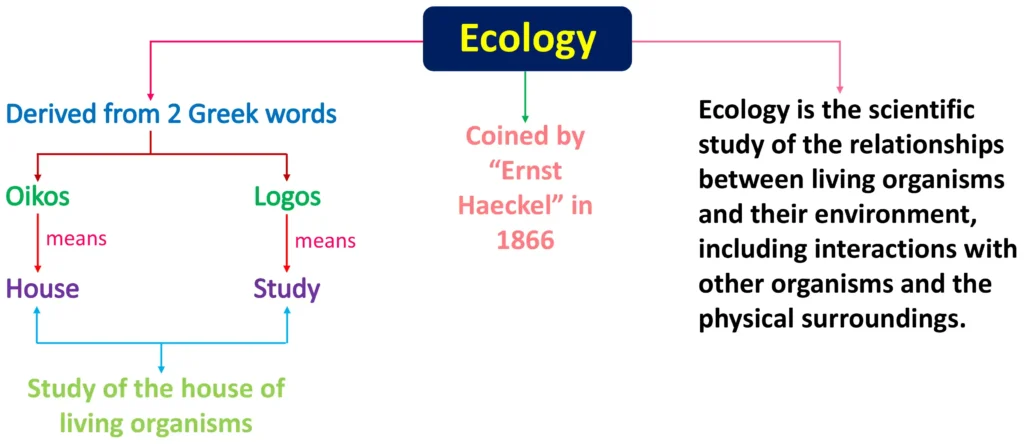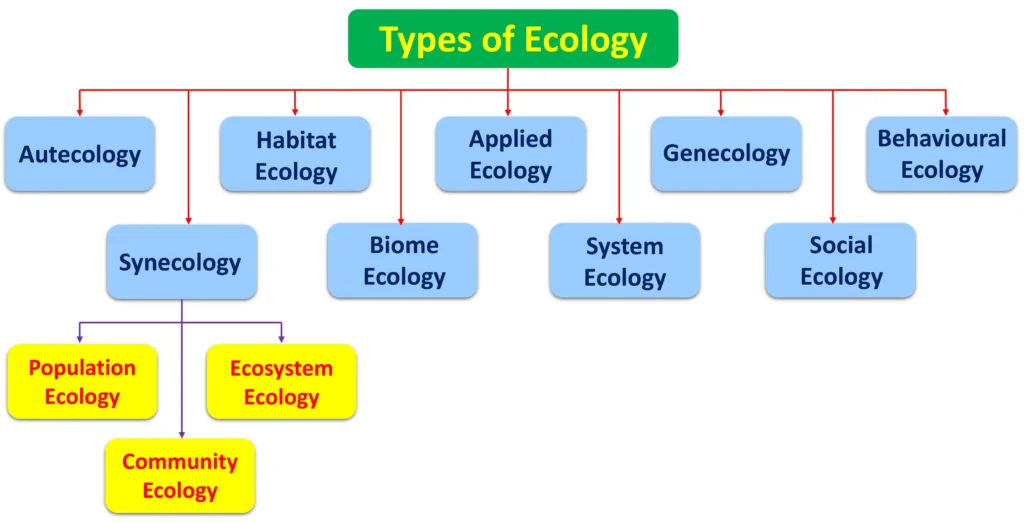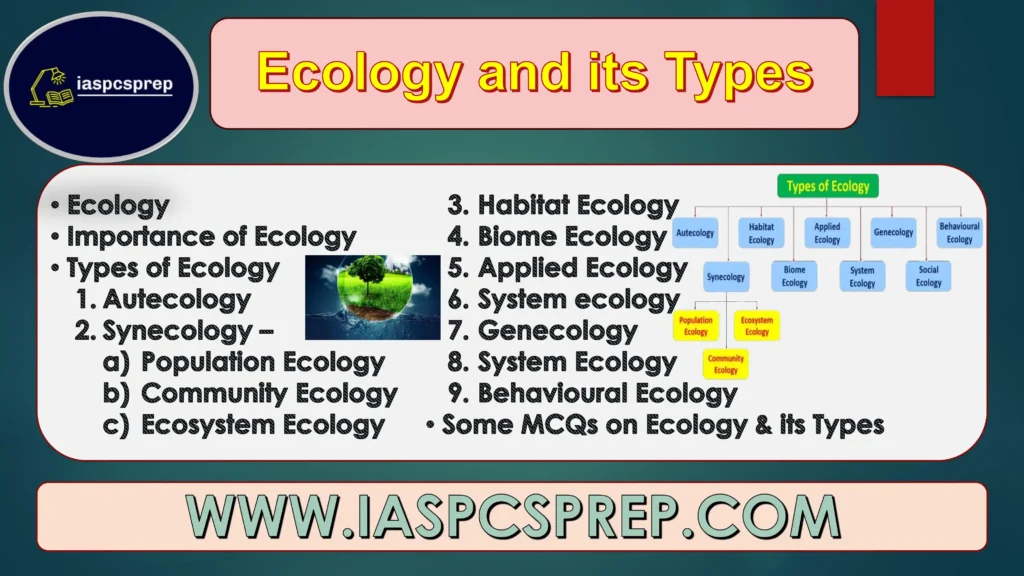| Ecology and its Types |
The link of PDF of this Ecology and its Types is given below the explanation of the class, you can download the PDF by going below.
Ecology and its Types
In this post of “Ecology and its Types”, we will discuss the meaning and definition of ecology and explore its various types, including autecology, synecology, population ecology, and ecosystem ecology, highlighting their significance in understanding the interactions between living organisms and their environment.
Ecology
- The word “Ecology” is derived from the Greek words – “Oikos” and “Logos”. Oikos means “home” or “place to live” and Logos means “study”. So, it means the study of the house of living organisms in which they live.
- The term “ecology” was first coined and used by the German Scientist “Ernst Haeckel” in 1866.
- Definition of Ecology: Ecology is the scientific study of the relationship between living organisms and their environment.
- According to Southwick (1976), “Ecology is the science of study of the relationship of living organisms with each other and their environment”.
- According to Stiling (2002), “Ecology is the study of interactions among organisms and between organisms and their environment.”
- Therefore, from the above definitions, it can be said that “Ecology is the scientific study of the interaction and interdependence among all living organisms together-with interaction with surroundings.
- Hence, Ecology helps us to understand how organisms depend on each other and interact with their environment for survival.

Importance of Ecology
Ecology is essential for maintaining balance in nature and ensuring the survival of all living beings. It helps conserve natural resources, protect biodiversity, reduce pollution, and promote sustainable agriculture.
The importance of ecology are as follows:-
1. Helps in Maintaining Balance in Nature
- Ecology ensures that all organisms live in harmony.
- It helps maintain a balance between different species.
- Example: The food chain—herbivores eat plants, and carnivores eat herbivores. If any species overgrows, the balance will be disturbed.
2. Conservation of Natural Resources
- Helps in the proper use of natural resources like water, forests, and soil.
- Protects resources from overuse and depletion.
- Example: Cutting too many trees leads to soil erosion and loss of biodiversity.
3. Protects Biodiversity
- Biodiversity means the variety of plants, animals, and microorganisms.
- Ecology helps in the conservation of different species and prevents their extinction.
- Example: Conservation of endangered species like tigers and rhinos through ecological studies.
4. Helps in Reducing Pollution
- Understanding ecology helps us find ways to reduce air, water, and soil pollution.
- Encourages eco-friendly practices like tree planting and waste management.
- Example: Trees absorb carbon dioxide and help improve air quality.
5. Helps in Better Agriculture
- Ecology helps farmers in soil conservation, pest control, and increasing crop production.
- Promotes sustainable farming practices.
- Example: Crop rotation maintains soil fertility, and organic farming reduces chemical use.
6. Supports Climate Change Awareness
- Helps in understanding how human activities affect the climate.
- Encourages eco-friendly habits like using less plastic and saving energy.
- Example: Using public transport instead of personal cars reduces pollution.
Ecology is essential for maintaining a healthy and sustainable environment. By protecting biodiversity, conserving resources, and reducing pollution, we can ensure a better future for all living beings.
Types of Ecology
Ecology is the study of how living organisms interact with each other and their environment. Based on the level of interactions and focus areas, ecology is divided into different types:-

1. Autecology (Species Ecology)
- It is the study of how a single species or individual organism interacts with its environment.
- It is also known as “Species Ecology”.
- It focuses on the growth, development, survival strategies, and behavior of one species in different environmental conditions.
- Examples:
- Studying the life of a tiger—its food habits, behavior, and hunting patterns.
- Understanding how a cactus survives in the desert with very little water.
2. Synecology (Community Ecology)
- It is the study of how group of organisms, many species or entire communities interact with each other.
- It is also known as “Community Ecology”.
- It examines the structure and organization of species, their behaviour and how they coexist, compete and cooperate in a shared habitat.
- Examples:
- A forest with trees, birds, insects, and animals interacting together.
- A coral reef with fish, corals and seaweed coexisting.
- Synecology is further divided into:
- (a). Population Ecology:
- It is the study of interactions within a group of the same species (called a population).
- It focuses on population size, growth, reproduction, and how they survive.
- Example: A herd of elephants in a jungle.
- (b). Community Ecology:
- It is the study of interactions between different species living in the same area.
- It focuses on how species depend on each other (like food chains).
- Example: Animals, plants, and microorganisms living together in a pond.
- (c). Ecosystem Ecology:
- It is the study of how living organisms (plants, animals, microbes) interact with non-living components (air, water, soil) in an environment.
- It focuses on:
- Energy Flow (how energy moves through food chains).
- Nutrient Cycle (like the carbon cycle, nitrogen cycle).
- How living and non-living components depend on each other.
- Examples:
- A pond ecosystem where fish, plants, water and sunlight interact.
- A desert ecosystem with cacti, sand, temperature and animals like lizard.
- (a). Population Ecology:
3. Habitat Ecology
- It is the study of specific habitats where organisms live and how they adapt to these conditions.
- It examines the conditions of the habitat like temperature, soil, sunlight, water, climate, and also examines How organisms survive in different habitats.
- Types of Habitat Ecology:
- Forest Ecology: Study of forests (e.g., Amazon Rainforest)
- Grassland Ecology: Study of grasslands (e.g., African Savanna)
- Freshwater Ecology: Study of rivers, lakes, and ponds (e.g., River Ganges ecosystem)
- Marine Ecology: Study of oceans (e.g., Pacific Ocean ecosystems)
- Coral Reef Ecology: Study of coral ecosystems (e.g., Great Barrier Reef)
- Examples:
- Studying how mangrove trees grow in salty coastal water.
- Observing aquatic plants in a freshwater lake.
- Studying how polar bears live in the Arctic, where it’s extremely cold.
- Understanding how camels survive in the hot deserts with very less water.
4. Biome Ecology
- It is the study of how large ecological regions, called biomes, function. A biome is a big area of land or water with a specific climate, distinct types of plants, animals, and environmental conditions.
- It focuses on how different biological communities (groups of plants, animals, and microorganisms) interact with each other and adapt to climatic conditions like temperature, rainfall, soil type, and sunlight in large areas.
- Examples:
- Tropical rainforests with dense trees and diverse wildlife.
- Tundras with cold climates, snow, and minimal vegetation.
5. Applied Ecology
- It is the study of using ecological knowledge to solve environmental problems and manage natural resources sustainably.
- It focuses on conservation, resource management, and reducing environmental issues like pollution and biodiversity loss.
- Examples:
- Wildlife conservation to protect endangered species.
- Sustainable farming to improve crop production without harming the environment.
- Pollution control to keep water bodies clean.
6. System Ecology
- This branch of ecology uses mathematical models and formulas to understand how ecological concepts and systems work.
- It describes complex ecological processes like energy flow and nutrient cycling with the help of formulas and models.
- Examples:
- Using computer models to predict climate change effects on the environment.
- Modeling the impact of deforestation on carbon dioxide levels.
7. Genecology
- It is the study of the genetic composition of organisms changes in response to different environmental conditions.
- It focuses on how genes help species adapt, survive, and evolve in various habitats, leading to the development of new species or ecotypes.
- Examples:
- Studying how wheat varieties develop resistance to drought in dry regions.
- Observing genetic changes in frogs that help them survive in polluted water.
- Understanding how polar bears have evolved thick fur and fat layers to survive in freezing temperatures.
8. Social Ecology
- The concept was introduced by an American thinker “Murray Bookchin”.
- This type of ecology connects ecological problems with social issues like poverty, inequality, and cultural conflicts.
- It suggests that to solve environmental problems, we must also address social issues such as poor governance, economic inequality, and industrialization.
- Focus:
- Human impact on the environment
- Solutions to both environmental and social issues
- Examples:
- Deforestation caused by industrial activities, affecting both nature and local communities.
- Impact of urbanization on green spaces and wildlife habitats.
9. Behavioural Ecology
- It is the study of how animals’ actions help them survive and reproduce in their environment.
- Focus: It looks at how animal behaviors, such as finding food, choosing mates, and protecting their territory, are influenced by things like the availability of resources or the presence of predators.
- Examples: Observing how animals like birds choose where to build their nests, based on where they can find enough food and stay safe from predators.
Some MCQs on Ecology and its Types
Q1. Who coined the term “ecology”?
a) Charles Darwin
b) Carl Linnaeus
c) Jean-Baptiste Lamarck
d) Ernst Haeckel
Answer: (d) Ernst Haeckel
Explanation: The term “ecology” was coined by the German biologist “Ernst Haeckel” in 1866. He derived it from the Greek words – oikos (meaning “home”) and logos (meaning “study”).
Q2. What does autecology focus on?
a) The study of multiple species in an ecosystem
b) The study of human impact on the environment
c) The study of individual organisms and their environment
d) The study of plant and animal interrelations
Answer: (c) The study of individual organisms and their environment
Explanation: Autecology focuses on studying how a single species or individual organism interacts with its environment, including both living and non-living factors.
Q3. Which type of ecology studies the flow of energy and nutrients through ecosystems?
a) Ecosystem ecology
b) Population ecology
c) Biome ecology
d) Habitat ecology
Answer: (a) Ecosystem ecology
Explanation: Ecosystem ecology examines how energy flows and nutrients cycle through different ecosystems, connecting the living and non-living components of an environment.
Q4. What is the primary concern of applied ecology?
a) Studying basic ecological concepts
b) Understanding the structure of ecosystems
c) Implementing ecological knowledge to solve environmental problems
d) Analyzing the behavior of endangered species
Answer: (c) Implementing ecological knowledge to solve environmental problems
Explanation: Applied ecology focuses on using ecological principles to address practical environmental issues such as conservation, resource management, and climate change.
5. Which of the following is NOT an example of a synecology study?
a) Studying how different plant species compete for sunlight in a forest
b) Studying the mutualistic relationship between bees and flowers
c) Studying the impact of predators on prey populations
d) Studying how squirrels adapt to cold weather
Answer: (d) Studying how squirrels adapt to cold weather
Explanation: Synecology looks at how species interact with each other. The adaptation of squirrels to cold weather would be studied in autecology, not synecology.
| Some Important Links | |
| Download Ecology and its Types PDF | Click Here |
| If you are satisfied with our website iaspcsprep.com, Please like and share with more people. | |
| Follow on Instagram | Follow Now |
| Join WhatsApp Group for PDF | Join Now |
| For any Query and Feedback, Contact Us at – study@iaspcsprep.com. | |


Related Posts:


